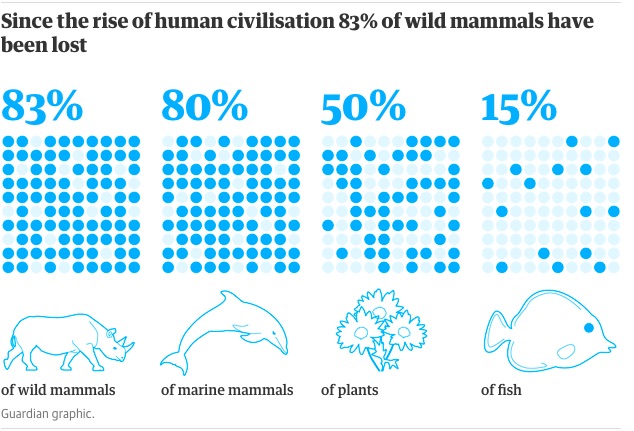Living in Balance with Our Wild Earth
Jun 21st, 2018 | By admin | Category: Water IssuesBy Suzanne York.
It’s an almost unbelievable statistic in an age of shocking facts – humans make up just .01% of all life on Earth but have destroyed 83% of wild mammals and 50% of plants since the dawn of civilization.Of all the mammals on Earth, 96% are livestock and humans and only 4% are wild mammals, according to a report last month in the Proceedings of the National Academy of Sciences.
If dominating the planet and wiping out other species isn’t enough, nature is sending humans other signs that we are living beyond our means, just in case we’re paying attention.
Take water, for instance. This most precious of resources is becoming more scarce for all of Earth’s inhabitants, especially in regions that can’t afford it.
A report by the Indian think tank, the National Institute for Transforming India (NITI),and several government agencies, found that 600 million people in India face high to extreme water stress. About three-fourth of the households in the country do not have drinking water at their premise, and nearly 70% of water is contaminated. It is estimated that 21 cities in India are likely to run out of groundwater by 2020. With erratic rainfall and a more unpredictable monsoon season, more people and towns will turn to dwindling groundwater supply. Yet the NITI analysts found that “Critical ground water resources that account for 40 per cent of India’s water supply are being depleted at unsustainable rates.”
India, with a current population of 1.4 billion, is projected to be the world’s most populous country by 2030.
Next door, in Pakistan, the country is enduring a drought that has resulted in a water crisis due to a poor monsoon season and lack of winter rains. Almost unimaginable temperatures have hit cities such as Karachi and the drought is affecting most of the nation.
According to a representative from the Pakistan Meteorological Department, the “burgeoning demand for water from Pakistan’s fast-growing population” is a main cause of the drought pressures. The current population of 208 million people is expected to double in the next 50 years.
In the Middle East and North Africa, the UN Food & Agriculture Organization said nations must prepare better for drought as water shortages look set to worsen in a region where fresh water resources are among the lowest in the world. The FAO reports that “Swelling populations and food demands, combined with even scarcer water and land resources, could lead to a doubling of food prices and trigger civil unrest in some developing countries.”
The U.S., of course, is not immune. Last year, California was hit hard with wildfires and will likely see many this summer. Trees have weakened due to climate change and beetle infestations. Other states in the west and southwest are in similar situations.
Not to be overlooked is the latest warning from the UN Intergovernmental Panel on Climate Change (IPCC) that cautioned, “If emissions continue at their present rate, human-induced warming will exceed 1.5°C by around 2040.”
The above news is just from the past week.
It’s not just population growth, consumption, exploitation, reliance on dirty energy and inefficient use of water resources. It’s short-sighted policies, greed, selfishness and ignorance. And where does Nature fit in? What happens to wild animals and plants when water runs scarce due to human needs and mismanagement, to put it lightly?
Pick your favorite analogy – the frog in the boiling water, the canary in the coal mine, sticking our head’s in the sand. All are apt. Yet we know how to change the situation. Switching from fossil fuels to clean energy, supporting smallholder farmers and agroecology, and changing our economic system that is based on unsustainable growth and exploitation of resources, to name a few. And living in balance with the planet.
Earlier this year, on World Water Day, the Director-General of UNESCO stated that “We need new solutions in managing water resources so as to meet emerging challenges to water security caused by population growth and climate change. The UN is supporting “Nature based solutions” as one approach to better water management, such as rainwater harvesting, planting trees to soak up storm water, and regenerating soils and forests.
Yes, we have our work cut out for us. Yet the alternative is to do nothing but maybe complain. The solutions are at our fingertips and are waiting to be implemented at full scale. The 4% of wild animals that remain need us to take action today.
Suzanne York is Director of Transition Earth.

![Giraffes in northern Uganda [photo: Suzanne York]](http://populationgrowth.org/wp-content/uploads/2018/06/giraffes-with-mountain-300x249.jpg)
![[photo: Atmospheric Research, CSIRO - Creative Commons]](http://populationgrowth.org/wp-content/uploads/2018/06/CSIRO_ScienceImage_607_Effects_of_Drought_on_the_Soil-300x197.jpg)
